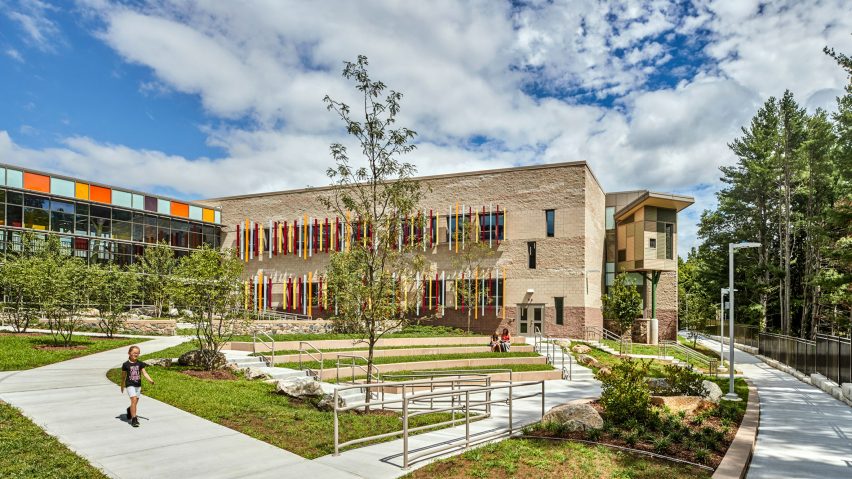Sandy Hook Elementary School in Connecticut, the site of the 2012 shooting that killed 20 children and six adults, has been rebuilt by architects Svigals + Partners to incorporate the latest anti-terror measures.
Working alongside the traumatised community of Newtown, Svigals + Partners designed the outside of the school to include a long walkway through a rain garden, intended to help the school "deter, detect and delay" potential intruders.
"Good buildings should prevent unwanted intrusions of any kind," Jay Brotman, managing partner of Svigals + Partners, told Dezeen.
"This approach leads us to explore how to keep intruders from gaining access from a building, often with layouts that reduce visibility from the street and direct traffic flow strategically in ways that allow potential threats to be detected early," he continued.
Meanwhile, the inside of the school is made to maximise escape routes – classrooms are situated far away from likely points of entry, and face towards a woodland, granting easy access to alternative exits. Each classroom is also equipped with locks and security doors.
"Other strategies are intended to delay the intruder's progress, including a facility plan that locates classrooms away from likely points of entry as well as locks and doors that impede progress," Brotman explained.
The strategies were decided through a series of workshops led by the architects, where security concerns were analysed by officials, members of the governing board, neighbourhood groups, parents and teachers.
"We truly wanted the architecture to reflect the heart of the community," Brotman said.
Nevertheless, Brotman warns that "building prosperous, compassionate communities cannot happen with a bunker mentality". He instead suggests the use of landscaping tactics, like bioswales – gently sloped hills that act as drainage systems to remove silt and pollution out of surface water runoff.
He also backed architect Stefano Boeri's suggestion to use large planters and trees to protect against terror attacks.
"More cities and new developments have trees, large planters and berms instead of walls and concrete barriers. They are equally effective in preventing attacks by vehicles," he said.
"Buildings and public spaces must be designed for many goals, and the most important are to encourage compassion, prosperity, collaboration and joy," he explained. "Nature, art and accessibility are just as important as security features."
The Sandy Hook Elementary School shooting occurred in 2012 in Newtown, Connecticut, when 20-year-old Adam Lanza fatally shot 20 children between six and seven years old, as well as six adult staff members.
The incident was regarded as the deadliest mass shooting at a school in US history and the forth-deadliest mass shooting by an individual in US history.
Recent terrorist attacks in cities including London, Paris and Barcelona have led to renewed efforts to make streets and buildings safer.
For instance, Paris major Jean-Louis Missika has said that robotic barriers could help city streets retain their beauty while protecting against vehicle-led terror attacks, while Florence has announced plans to adopt Boeri's "anti-terror" planters proposal.
Designing out terrorism was the topic of a discussion at Dezeen's Good Design for a Bad World talks in Eindhoven this weekend.
Photographs by Robert Benson.

